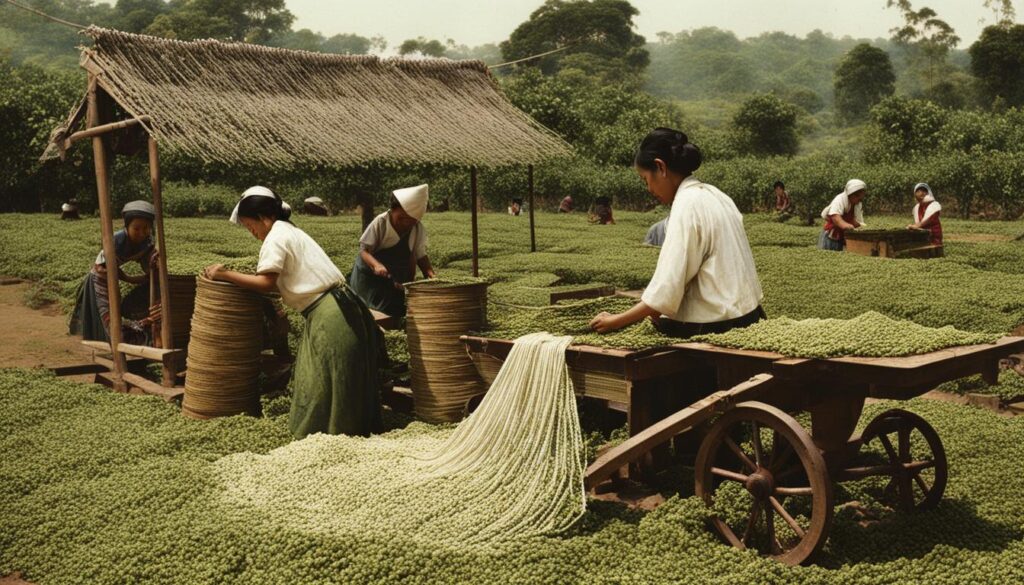The region between the Platte and Arkansas Rivers and east of the Rocky Mountains has long been a Cultural Crossroads, where different peoples lived with shifting resources and engaged in trade for more. Native American tribes such as the Ute, Cheyenne, Arapaho, Comanche, Kiowa, and Apache, as well as European colonists and fur traders, all contributed to the cultural influences of the area. The exhibit at the Colorado Springs Pioneers Museum showcases the creative innovation and adaptation of native peoples in this region, highlighting the impact of cultural factors on scarcity and behavior.
Key Takeaways:
- Cultural influences shape scarcity and behavior in societies.
- Native American tribes and European colonists played a significant role in the cultural development of the region.
- The Colorado Springs Pioneers Museum exhibit explores the impact of cultural factors on scarcity.
Networks of Trade Along the Silk Road
The Silk Road, a vast network of trade routes, connected various regions across Asia and Europe, enabling the exchange of goods, ideas, and cultural influences. This ancient trading network played a pivotal role in shaping perceptions of scarcity and societal behavior.
The Silk Road spanned from China to countries such as Korea, Japan, Central Asia, India, Turkey, and Italy. It served as a conduit for the transportation of highly coveted commodities, including silk, cotton, wool, glass, jade, gold, and spices. These goods were not only valued for their material worth but also for their cultural significance, symbolizing wealth, luxury, and refinement.
However, it was not just physical goods that traveled along the Silk Road. Ideas, traditions, and knowledge were also exchanged, fostering cultural exchange and intellectual growth. This cross-pollination of ideas and experiences led to the development of unique art forms, architecture, and religious practices.
The Silk Road was not without its challenges. Traveling along treacherous terrains and navigating political boundaries proved to be arduous and risky. Yet, the demand for the Silk Road’s commodities and the allure of silk itself ensured the persistence and endurance of this trading network.
The Cultural Impact of the Silk Road
The exchange of goods and ideas along the Silk Road had a profound cultural impact on the civilizations it connected. Different cultures adopted and adapted the commodities and practices they encountered, infusing their own traditions and beliefs.
“The Silk Road was not just a means of trading physical goods; it was a pathway for the exchange of knowledge, art, and culture. This network of routes fostered a creative exchange that transcended geographical boundaries and connected diverse civilizations.” – Dr. Li Mei, Historian
The influence of the Silk Road can be seen in various aspects of cultural expression. For instance, the art of silk weaving spread beyond China, with countries like Japan embracing it and developing their unique styles, as exemplified by the elegant kimonos. In Central Asia, the fusion of cultural elements from diverse regions, facilitated by the Silk Road, shaped the vibrant and colorful patterns found in traditional carpets and textiles.
The impact of the Silk Road extended to religious practices as well. Buddhism, originating in India, spread along the Silk Road, reaching as far as China and Japan. The blending of Buddhist beliefs with local customs gave rise to distinct schools of Buddhism and influenced the art, architecture, and philosophy of these regions.
The cultural legacy of the Silk Road continues to be celebrated and studied today, providing insights into the interconnectedness of diverse societies and the power of cultural exchange.
| Commodity | Origin | Destination |
|---|---|---|
| Silk | China | Various regions across Asia and Europe |
| Spices | India, Southeast Asia | Various regions across Asia and Europe |
| Glass | Mesopotamia, Egypt | China, Central Asia, Europe |
| Jade | China | Various regions across Asia |
The Influence of Cultural Expectations on Decision-Making
Cultural expectations play a significant role in shaping individual decision-making processes. These expectations are rooted in the standards and norms of social groups and can greatly influence the choices people make in various aspects of their lives. Whether it’s familial systems, geographic regions, or organizations, cultural expectations deeply impact societal behavior.
One example of how cultural expectations affect decision-making is in the realm of educational attainment. Many societies hold the belief that completing postsecondary education is necessary for success and personal fulfillment. These expectations are ingrained in various social systems, including families, communities, and employers. As a result, individuals may feel pressured to pursue higher education, even if it may not align with their personal goals or aspirations.
Awareness of cultural expectations is crucial to avoid making decisions solely based on societal norms. It is important for individuals to consider their own values, passions, and interests when making choices. By understanding the influence of cultural expectations on decision-making, individuals can ensure that their decisions align with their personal goals and contribute to their overall fulfillment.
Effects of Cultural Expectations on Decision-Making
The influence of cultural expectations on decision-making can have various effects on individuals. Some of these effects include:
- Conforming to societal norms: Cultural expectations can create a sense of conformity, leading individuals to make decisions that align with societal norms, even if it may not reflect their personal desires.
- Rejection of alternative paths: Cultural expectations may discourage individuals from pursuing alternative paths that deviate from the established norms. This can limit individual creativity and innovation.
- Perception of success and failure: Cultural expectations shape the perception of success and failure. Individuals may feel successful or unsuccessful based on how well they meet societal expectations.
- Impacting career choices: Cultural expectations can influence career choices, pushing individuals towards professions that are considered prestigious or socially respected.
It’s essential for individuals to critically reflect on the cultural expectations that influence their decision-making processes. By doing so, they can navigate their own path towards personal fulfillment and make choices that align with their true aspirations.
“Cultural expectations can significantly influence decision-making, often leading individuals to conform to societal norms rather than pursuing their own passions and desires.” – [Author Name]

| Cultural Expectations | Effects |
|---|---|
| Conformity to societal norms | Can limit individual expression and creativity |
| Discouragement of alternative paths | May hinder personal growth and exploration |
| Perception of success and failure | Can lead to feelings of satisfaction or dissatisfaction |
| Impact on career choices | May influence the pursuit of socially respected professions |
The Significance of Silk and Its Cultural Impact
Silk production originated in ancient China around 3000 B.C.E., with the cultivation of silkworms and the development of silk reeling techniques. The unique qualities of silk, such as its strength, absorbency, and draping properties, made it highly valued for clothing, rituals, and trade.
The cultural impact of silk extended beyond China, influencing diverse civilizations around the world. Silk became deeply intertwined with the social fabric of various societies, symbolizing social status, cultural identity, and artistic expression. Its luxurious nature and fine craftsmanship made silk a coveted commodity, with global trade routes facilitating its spread.

The symbolism of silk can be seen in different cultures and their silk products. For example, in Japan, silk is closely associated with their traditional attire, such as kimonos, which exemplify the elegance and cultural heritage of the country. In China, silk was used not only for clothing but also for burial shrouds, reflecting its deep-rooted cultural significance and belief in the afterlife.
“Silk became a medium of cultural exchange, transcending borders and connecting civilizations.”
The global trade of silk fostered cultural exchange and appreciation for diverse traditions. As silk traveled along trade routes, it carried with it not only a luxurious fabric but also the ideas, customs, and innovations of the civilizations it touched. This cultural influence can be seen in the artistic motifs and techniques found in ancient silk textiles, showcasing the power of silk to connect and inspire people across time and continents.
The significance of silk in different cultures highlights the profound impact of cultural influences on material culture. From its origins in ancient China to its adoption and adaptation in various societies, silk exemplifies the intertwining of craftsmanship, tradition, and cultural symbolism on a global scale.
How Does Scarcity Impact Different Generations in Various Societies?
The impact of scarcity’s legacy from generation is seen differently across societies. Older generations in developing countries often have experienced severe scarcity, shaping their frugal mindset. In contrast, younger generations in developed nations may not fully grasp scarcity’s impact, leading to a sense of entitlement. Economic and cultural factors play a significant role in shaping these perspectives.
How Does Cultural Differences Affect the Perception of Scarcity in Different Societies?
Cultural differences play a significant role in the impact of scarcity mindset in various societies. In some cultures, scarcity is viewed as normal, while in others it creates fear and anxiety. Perception of scarcity can influence behavior, decision-making, and overall well-being, shaping the dynamics of different communities.
Conclusion
Cultural influences are significant in shaping perceptions of scarcity and impacting societal behavior. The Cultural Crossroads in Colorado and the Silk Road exemplify how cultural factors intertwine with historical trade networks and social systems to create a complex web of influences. The experiences of various civilizations along the Silk Road demonstrate the power of cultural exchange in fostering global connections and shaping societies worldwide.
Understanding how cultural expectations and norms shape decision-making is crucial for personal fulfillment and avoiding discontentment with life choices. The examples of educational attainment highlight the profound impact of cultural expectations on individuals’ decisions and paths. Being aware of these cultural influences can help individuals make choices that align with their own values and aspirations.
Cultural exchange and globalization have further reinforced the interconnectedness of societies. The universality of human experiences and the powerful role of culture in shaping societal behavior are evident through global connections. Whether it is the sharing of ideas, traditions, or commodities, cultural influences continue to shape and transform societies around the world.
FAQ
How do cultural influences impact scarcity and societal behavior?
Cultural influences, such as societal norms and spending patterns, play a pivotal role in shaping perceptions of scarcity and impacting societal behavior. They contribute to the creation of a complex web of influences that vary across societies.
What is the Silk Road and how did it shape perceptions of scarcity?
The Silk Road was a network of trade routes connecting China to various regions, facilitating the exchange of goods, ideas, and cultural influences. This exchange played a significant role in shaping perceptions of scarcity by disseminating knowledge and fostering creative exchange between diverse civilizations.
How do cultural expectations influence decision-making?
Cultural expectations, communicated through rules, rituals, and actions, shape individual choices based on social group norms. These expectations impact decision-making within familial systems, geographic regions, and organizations, and can significantly influence choices and paths in areas such as education and personal fulfillment.
What is the cultural significance of silk and its impact on different societies?
Silk production originated in ancient China and its unique qualities made it highly valued for clothing, rituals, and trade. Silk’s association with social status, cultural identity, and artistic expression led to its adoption and adaptation in various societies, evident in the variety of silk products found worldwide.
Why is it important to understand cultural influences?
Understanding cultural influences is essential to achieving personal fulfillment and avoiding dissatisfaction with life choices. Cultural factors intertwine with historical trade networks and social systems, shaping societies worldwide and highlighting the powerful role of culture in shaping behavior and global connections.

